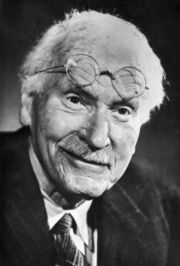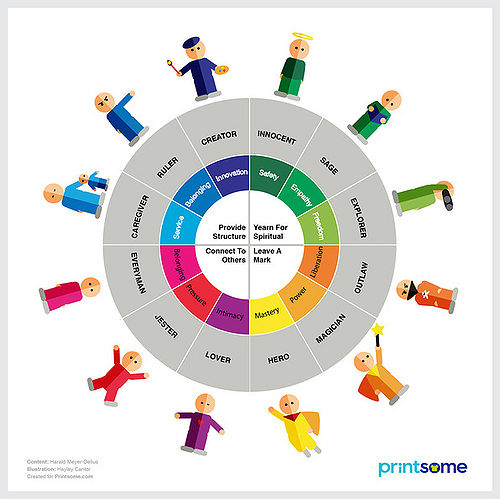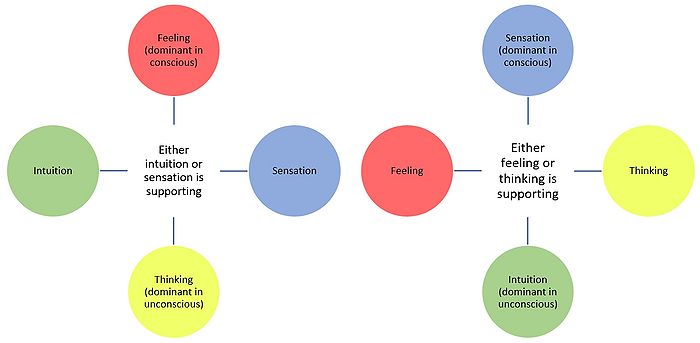Jung's personality Theory
| Line 1: | Line 1: | ||
| − | [[File:carl_gustav_jung.jpg|thumb|Carl Gustav Jung https://thereisonlygod.wordpress.com/tag/carl-gustav-jung/]] | + | [[File:carl_gustav_jung.jpg|thumb|Carl Gustav Jung <ref name=''Interview with Carl Gustav Jung''> ''https://thereisonlygod.wordpress.com/tag/carl-gustav-jung/ retrieved on Sep. 27. 2017'' </ref> ]] |
| Line 52: | Line 52: | ||
By using the above described functions there are a total of 8 different possible combinations which a person can be. These 8 psychological types are formed from a person either being introvert or extravert and the persons dominant function. As Jung also pointed out it is important to remember that a whole personality does not consists of only two preferences, but also a third which is the conscious supporting function. Subconsciously the rest of the functions are also present. | By using the above described functions there are a total of 8 different possible combinations which a person can be. These 8 psychological types are formed from a person either being introvert or extravert and the persons dominant function. As Jung also pointed out it is important to remember that a whole personality does not consists of only two preferences, but also a third which is the conscious supporting function. Subconsciously the rest of the functions are also present. | ||
| + | |||
| + | |||
| + | |||
| + | |||
| + | |||
| + | = References = | ||
| + | <references/> | ||
| + | =Annotated bibliography= | ||
| + | :'''1. Winch, G. M. (2010), "Managing Construction projects". Second edition TEST BIB''' | ||
Revision as of 07:30, 27 September 2017

The psychiatrist Carl Gustav Jung was born and lived I Switzerland. His research was centered around the psychoanalyses of humans and is today very often used to coordinate and make teams in work situations. If a project manager understands the basis of Jung’s personality theory’s he will be capable of grouping teams based on their individual personality trades. If teams are grouped based on this theory the team will complement each other and many conflicts can be avoided. Jung meant that people was defined by their characteristics within the following three groups:
- Extraversion – introversion
- Sensing – intuition
- Thinking – feeling
Jung refers to these to the If a team is put together to compliment the above areas there will, according to Jung, be an optimal team dynamic.
Jung’s work is built around different personality types and analysis of dreams. During his professional life, he was very influenced by Freud and big parts of Jung’s work is developed on Freuds thoughts of the human mind. Jung’s personality theory is especially of interest for project managers because it connects the psychoanalysis way of thinking with today’s personality tests. Because Jung opposed to e.g. Freud sees the individual mind as energy that influences the future of the individual. The energy decides how the future should look like and therefore forms e.g. hope, goals, desires ect. For the future. Where is many like Freud only looked at the past.
In the following it will be explained how Jung saw the mind and especially how it can be used I management when different teams and workgroups are put together. Today one of the best-known personality test’ is the MBTI test which is built primarily on Jung’s personality theory.
Contents |
Carl Gustav Jung
C. G. Jung was born in Switzerland on the 26. Of July 1875 and died the 6. Of June 1961. Jung was a psychiatrist and later also became a psychoanalyst at the Burghölzli hospital, which is the psychiatric hospital of Zürich university. During Jung’s career, he founded the analytical psychology and is today especially known for his work with dream analysis, human psyche and personality theory.
As Jung became more and more famous for his work Sigmund Freud reached out and the two men decided to collaborate on a joint vision regarding the human psychology. Because of this cooperation between the two Jung’s work became very influenced by Freud’s visions and their work can in some aspect be difficult to distinguish between the two. Eventually Jung choose to focus on the present while Freud continued to focus on the past and the subject’s child hood. This led to a break between the two, which had a personal and a work vise influence on Jung.
Jung’s focus on the present day is what makes his personality theory’s especially relevant for project managers. One of Jung’s central concepts was the individuation. This concept is a part of the analytical psychology and is the concept on how humans has a lifelong process of differentiation of the self-persona. According to Jung the consciousness and unconsciousness of the individual is in a lifelong process of differentiating the self-persona. One part of this concept is the extraversion and introversion aspects, which will be explained in detail later in the article.
Jung’s perspective on the mind
Jung saw the mind as two different parts and how they interacted on each other. He distinguished between the persona and the shadow of the mind. The persona is defined as how we present ourselves to the world, the picture we let others see. While our shadow is the compressed part of us. The shadow often hides our fears and flaws. Besides this Jung noted that the mind consists of a personal unconscious and a collective unconscious. The personal unconscious is the persons own memories and experiences while the collective unconscious is the experiences of the species that have been past trough DNA. Jung described the different types of conscious and unconscious personality’s as archetypes. These types are universal and can be used to identify our persona and therefore get a deeper understanding of why different people act as they do. From greek the word arche means original and typos means pattern. The Archetypes is in its basic 12 different personality types that describes the original pattern of a mind.

Personality types
Jung distinguish between to bases of personalities, extroverts and introverts. If a person is categorized as extrovert the person is very outgoing and prefers to be among people to socialize. In opposite, the introvert person prefers to be alone and is much more comfortable in his own company. In other words, an introvert is stimulated from within himself while an extrovert person gets stimulated by outside environments. Jung himself explained this in one of his books:
"....The introvert's attitude to the object is an abstracting one.... he is always facing the problem of how libido can be withdrawn from the object...... The extravert, on the contrary, maintains a positive relation to the object. To such an extent does he affirm its importance that his subjective attitude is continually being orientated by, and related to the object...." Source: Psychological Types by C. G. Jung 1921 http://www.businessballs.com/personalitystylesmodels.htm#carl jung's personality types 21-09-2017 18:00
As an example, we could look at Julie. Julie prefers to spend her Friday night out with friends and often she has plans the entire weekend. She loves to interact with lots of different people and she probably has a big circle of friends. On the contrary Dan prefers to stay home, read books and watch movies by himself all weekend. Dan most likely only have few, but close friends. Julie is an extrovert while Dan is an introvert person. It is tough important to know that there is no such person that is 100 % extrovert or introvert, as Jung also said himself: There is no such thing as a pure introvert or extrovert. Such a person would be in the lunatic asylum. C. G. Jung source: https://www.brainyquote.com/quotes/quotes/c/carljung717968.html 21-09-2017 18:00
When people are grouped into introvert – extroverts Jung subdivides people even further. People are categorized after how they perceive the world and how they make decisions. Jung categorize after the following four groups, called the functional types:
The irrational functions - How we perceive environments and gather information
- Sensing
When a person is in this group the person likes to use aesthetics in everyday situations. The person prefers that everything is in line, symmetric and so on. Dan ex prefers that if there is one lamp on his desk, there must be one more opposite of the first to balance the desk. If thinks are in ‘balance’ Dan feels satisfied and can better focus on the task ahead of him. - Intuition
Opposite of sensation there is the people who goes for their intuition. When a person relay mostly on intuition he uses his unconscious to decide in any kind of situations and environments. When Julie decorates her living room she might use two different kinds of chairs and a third type for the couch. A person like Dan would have not liked if the furniture were not part of a set that matches each other.
The rational functions - How we make decisions or judge
- Thinking
When a person uses facts and reasoning to decide in situations they encounter. Often an engineer is in this category while an artist feels the situations and decides upon that. A person in this category asses the different outcomes and analyses the situation before making a decision or move. - Feeling
A person who relies on feelings uses his personal experience and goes with whatever feels right. This would typically be a creative people.
Jung arranged his functions to be opposite. One person cannot function properly without having pairs of preferences from the rational and the irrational group. A person possesses both the ability to use sensing and intuition but will always prefer one over the other, i. e. one function will always dominate while the other is supporting. The same goes for thinking vs. feeling. It is important to note that the persona of a person possesses the dominant functions while the unconscious will dominantly possess the opposite functions, this is to balance the individual. See the examples below.
By using the above described functions there are a total of 8 different possible combinations which a person can be. These 8 psychological types are formed from a person either being introvert or extravert and the persons dominant function. As Jung also pointed out it is important to remember that a whole personality does not consists of only two preferences, but also a third which is the conscious supporting function. Subconsciously the rest of the functions are also present.
References
- ↑ https://thereisonlygod.wordpress.com/tag/carl-gustav-jung/ retrieved on Sep. 27. 2017
Annotated bibliography
- 1. Winch, G. M. (2010), "Managing Construction projects". Second edition TEST BIB
